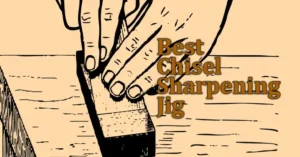Imagine spending hours carving a delicate wooden bowl, only to hear a crack as your chisel snaps in half. Why? You accidentally used a cold chisel instead of a wood chisel. Oops.
Wood chisels and cold chisels look similar, but using the wrong one can wreck your project and your tools. Now, a question: Wood Chisel vs Cold Chisel, which should you buy? Here, you’ll learn:
- The critical design differences between the two.
- When (and when not) to use each tool.
- Top-rated chisels for wood, metal, and DIY tasks.
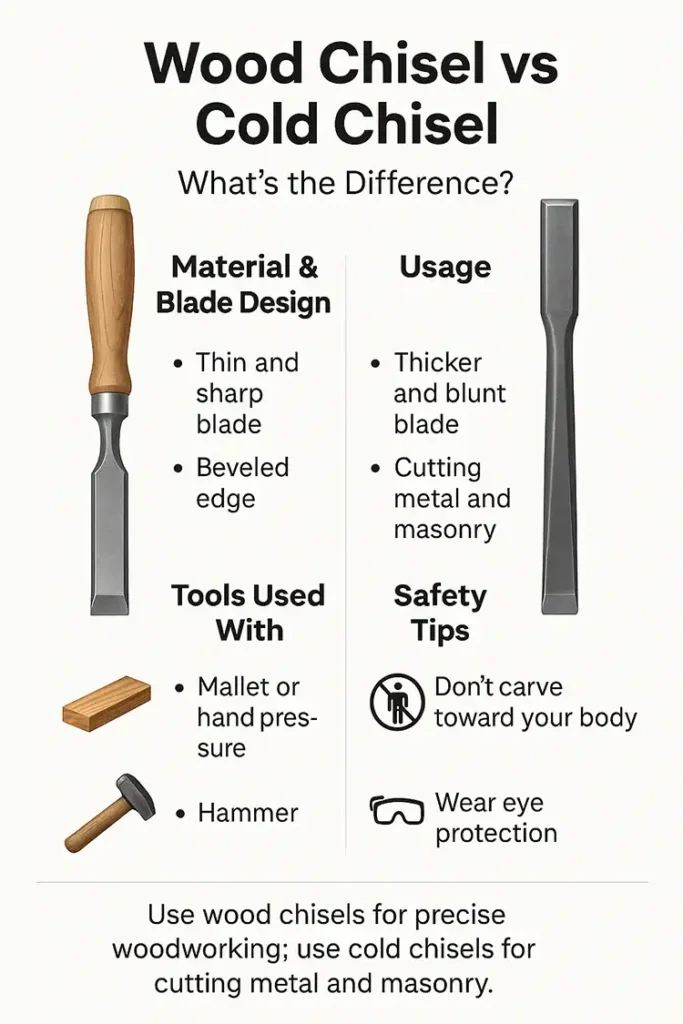
Table of Contents
Wood Chisels: Types, Key Features, Uses, Anatomy
What is a wood chisel?
A wood chisel is a sharp-bladed hand tool for cutting, carving, or shaping wood. It’s essential in woodworking.
Types of wood chisels:
- Bench chisel: General use, for cutting and shaping.
- Mortise chisel: Thick blade for carving joints.
- Paring chisel: Long, thin blade for smoothing wood.
- Carving chisel: Small, detailed designs (e.g., sculptures).
Key Features:
- Strong steel blade (stays sharp longer).
- Comfortable handle (wood, plastic, or rubber).
- Sharp edge for clean cuts.
Common Uses:
- Carving shapes or patterns.
- Making joints (e.g., door frames, furniture).
- Trimming excess wood.
- Smoothing rough surfaces.
Anatomy:
- Blade: The metal part that cuts.
- Bevel: Angled edge for sharpness.
- Tang: Blade part inside the handle.
- Ferrule: Metal ring holding handle and blade.
- Handle: Gripped by hand.
Design Characteristics:
- Blade width varies (narrow for details, wide for big cuts).
- The handle shape fits the hand comfortably.
- Bevel angle changes based on wood hardness.
- Lightweight for easy control.
Cold Chisels: Types, Key Features, Uses, Anatomy
What are Cold Chisels?
A cold chisel is a heavy-duty metal tool for cutting or shaping hard materials like metal, stone, or brick.
Types of cold chisels:
- Flat chisel: Flat blade for cutting metal or splitting stone.
- Cape chisel: Narrow blade for making grooves.
- Diamond point chisel: Pointed tip for marking or chipping precise shapes.
- Round-nose chisel: Curved blade for carving grooves or curves.
Key Features:
- Made of hardened steel (doesn’t bend easily).
- Sharp, beveled edge for cutting.
- Tough handle (often metal with a grip).
Common Uses:
- Cutting metal bars, bolts, or wires.
- Removing old rivets or nails.
- Shaping stone or brick in construction.
- Carving slots or marks in hard materials.
Anatomy:
- Head: The Top part hit by the hammer.
- Blade: Sharp cutting edge.
- Bevel: Angled edge for strength.
- Body: The Middle part connecting the head and the blade.
Design Characteristics:
- Thick head to handle hammer strikes.
- Blade angle varies for different materials.
- Heavy-duty construction to resist breaking.
- Shorter and sturdier than wood chisels.
Key Differences: Wood Chisel vs Cold Chisel
Comparison Table for Wood Chisel vs. Cold Chisel:
| Feature | Wood Chisel | Cold Chisel |
|---|---|---|
| Blade Material | High-carbon steel | Alloy/tool steel |
| Edge Angle | 20°–30° (sharp) | 60°–75° (blunt) |
| Handle | Wood/plastic (lightweight) | Metal with rubber (durable) |
| Best For | Woodworking | Metal, masonry, demolition |
Critical Notes:
- Safety: Never use a wood chisel on metal—it can shatter and cause injury.
- Cost: Cold chisels are cheaper (10–20), while wood chisels range from 15–100+.
When to Use Each Tool: Wood Chisel vs Cold Chisel
Not all chisels are created equal. Choosing the right tool for the job is key to getting clean results and avoiding damage. Here’s when to use each type:
Use a Wood Chisel When…
A wood chisel is designed for woodworking tasks where precision and finesse matter. Use it for:
- Shaping and Carving Wood: Perfect for sculpting, trimming, and creating detailed designs in soft or hardwood.
- Making Mortise, Tenon, or Dovetail Joints: Essential for crafting tight-fitting joints in furniture or cabinetry.
- Smoothing and Paring: Ideal for removing thin shavings and cleaning up rough edges or joints.
- Trimming Around Hardware: Great for carving out space around hinges, locks, or other fixtures.
Tip: Use a wooden mallet for controlled striking without damaging the chisel handle.
Use a Cold Chisel When…
A cold chisel is made from hardened steel and built to take on tougher materials. Use it for:
- Cutting or Splitting Metal: Handy for cutting bolts, rivets, or sheet metal without power tools.
- Removing Rusted Fasteners: Slice or break stuck screws, bolts, or other metal parts.
- Breaking Masonry or Concrete: Ideal for scoring and breaking bricks, stone, or concrete.
- Cleaning Welds: Remove excess metal and smooth out welded seams.
Tip: Always wear safety goggles—cold chisels can send sparks and metal fragments flying.
❌ What Not to Do:
- Don’t use a wood chisel on metal or stone. You’ll ruin the edge instantly.
- Don’t use a cold chisel on wood. It’s too aggressive and will damage the material.
Top Product Recommendations for Woodworking and Metalworking
Best Wood Chisels:
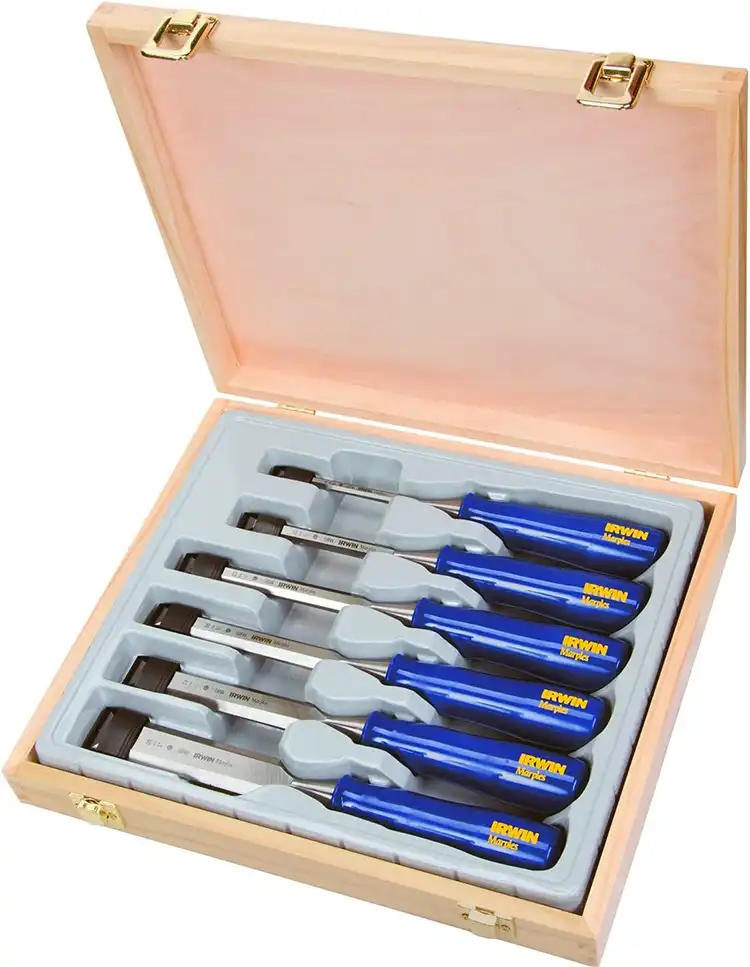
IRWIN Marples Bevel Edge Premium Chisel Set of 6
“Razor-sharp blades and ergonomic handles for precision work.”
Price: $61.67 (6-piece set) | Check Current Price on Amazon
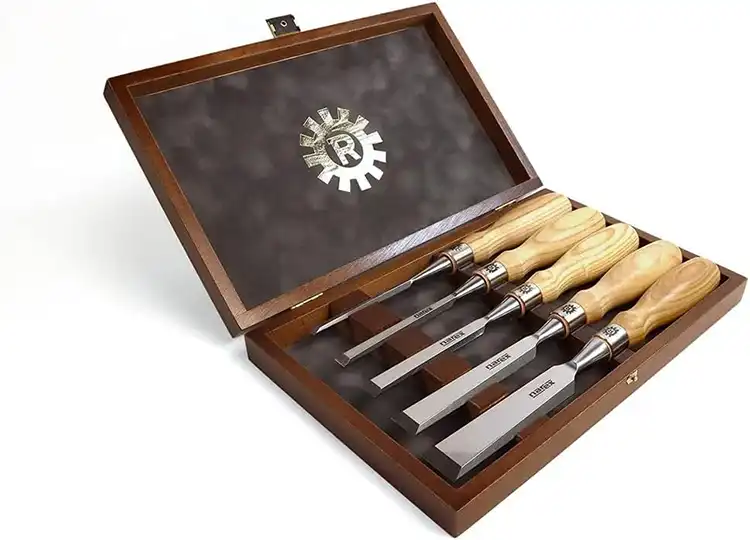
Narex Richter Bevel Edge Chisel Set of 5
Premium Czech steel for Extra-Heavy Duty professional woodworkers.
Price: (-13%) $218.24 | Check Current Price on Amazon
Best Cold Chisels:
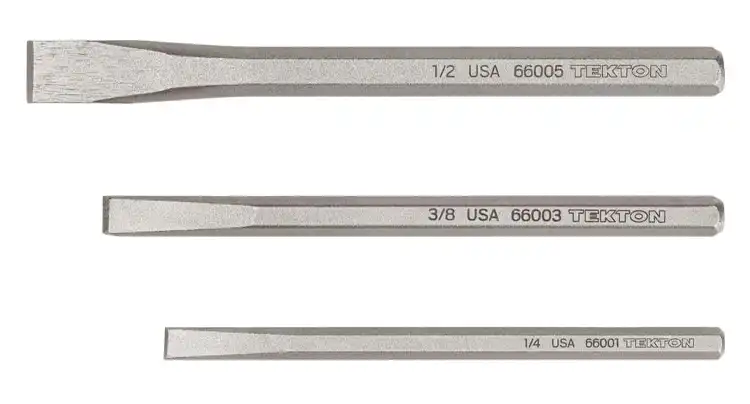
TEKTON Cold Chisel Set, 3-Piece (Made in USA)
Affordable, durable, and ideal for home workshops.
Price: $15.00 | Check Current Price on Amazon
Common Mistakes to Avoid
Wood Chisels:
- Dull blades: Cause splintering instead of clean cuts. Sharpen regularly.
- Wrong angle: Holding the chisel incorrectly leads to slips or uneven cuts.
- Hammering too hard: Using a metal hammer (not a mallet) can split wooden handles.
- Not securing the wood: Unstable workpieces increase injury risk.
Cold Chisels:
- Striking improperly: Missing the chisel head risks hitting hands or damaging the tool.
- Using the wrong type: Flat chisels for metal, cap chisels for grooves—using the wrong one reduces efficiency.
- No safety gear: Not wearing goggles lets metal chips fly into the eyes.
- Overheating: Repeated strikes can soften hardened steel—cool occasionally.
Shared mistakes:
- Neglecting sharpness: Blunt tools require more force and are unsafe.
- Poor grip: Slipping causes injuries or ruined work.
- Ignoring wear: Cracked handles or mushroomed heads (on cold chisels) risk breaking during use.
Note: Always work slowly, secure materials, and use proper safety gear!
Final Though
Why Picking the Right Chisel Matters (and How to Do It!)
Choosing between a wood chisel and a cold chisel isn’t just about the job—it’s about saving time, money, and your safety. Here’s the deal:
Wood chisels are your go-to for carving, shaping, or trimming wood. They have razor-sharp edges (like a kitchen knife!) to slice cleanly through wood fibers.
Cold chisels are the muscle for metal, stone, or concrete. Their blunt, tough edges smash through hard materials without breaking.
Use the wrong one? You’ll ruin your project and your tool. For example:
- A wood chisel on metal = shattered blade.
- A cold chisel on wood = jagged, splintered edges.
Stay safe and get better results with these tips
- Match the tool to the task (wood vs. metal).
- Sharpen wood chisels regularly—dull tools slip and cause injuries.
- Wear safety goggles—flying metal or wood chips are no joke!
Pro Tip: Clean and oil your chisels after use to prevent rust. A $20 chisel can last decades with proper care!
Check out our guide:
- Wood Chisels 101: How to Choose, Use & Buy Like a Pro.
- Best 10 Milwaukee Cutting Tools: The Perfect Companion for Your DIY Projects
- The 5 Best Makita Rotary Hammer: Dominate Your Projects 2024
- 14 Different Types of Bricklaying Tools (How to Use Them) in 2024
- 33 Different Types of Wrenches in the USA | How to Use Them?
FAQs
Can I sharpen a cold chisel like a wood chisel?
No, use a grinder, not a honing stone, for cold chisels.
Which chisel is best for removing nails?
A cold chisel’s sturdy blade won’t bend under pressure.
Can I use a wood chisel on metal or a cold chisel on wood?
No, wood chisels are for wood; cold chisels are for metal. Using them interchangeably can damage the tool and material.
What are wood and cold chisels made of?
Wood chisels have steel blades with wooden or plastic handles. Cold chisels are made entirely of hardened steel.
How do their blade angles differ?
Wood chisels have a bevel angle of 25–30°, while cold chisels have about a 60° angle.
Are there different types of wood and cold chisels?
Yes, wood chisels include bench, mortise, and paring chisels. Cold chisels include flat, cross-cut, and cape chisels.
How should I maintain my chisels?
Regularly sharpen, clean, and store them properly to prevent damage and rust.


